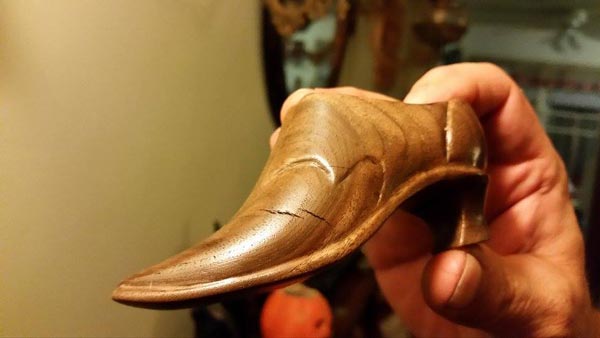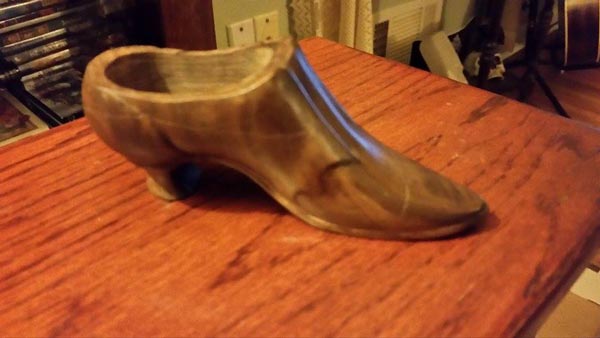I enjoy this sort of mystery, so I dug a bit deeper. In “A History and Price Guide to
Miniature Shoes,” Zita Thornton has this to say:
Modern, ornamental shoes made from porcelain or resin, have
become a collectable favourite in the last few years. However, a fascination
with miniature shoes goes back thousands of years. Miniature
sandals have been found in Egyptian tombs and fashioned from ancient
Persian pottery.
When shoemaking became a highly skilled, decorative craft in the
seventeenth century, shoe makers expressed their skill in miniature too.
Until the nineteenth century, miniature shoes, as exquisite in their
detail as their full sized counterparts, became tokens of prosperity and
love and symbolised a desire to share worldly goods, hence the
tradition of hanging boots on the back of a newly wed’s car.
The emergence of porcelain brought the fashion to aristocratic
circles when elegant but expensive porcelain or enamel versions were
exchanged. In the nineteenth century the love of novelty encouraged
the manufacture of miniature shoes in a wider variety of materials such
as leather, wood and brass and brought the custom within the reach of
sentimental Victorians of all classes. The less sentimental looked for a
function in their ornamental shoes and in this they were continuing a
tradition that had its roots in ancient times. The Romans had oil lamps
shaped as a foot in a sandal, and perfume containers as hob nailed
boots. An ancient ancestor of the stirrup cup was a drinking vessel
called a rhyton, which was sometimes made in a boot shape. Victorian
gentlemen had shoes fashioned as gin flasks, umbrella handles, paper
knives and ink wells, as well as all the paraphernalia associated with
smoking and snuff taking such as snuff boxes, match holders, tobacco
jars, ashtrays and pipe stops.
I’ve seen this snuff box before, but thought I’d share an image and its story, because it give us some information on our question…
This snuff box was owned by the artist Talbot Hughes (1869-1942), who had a large collection of historic dress and accessories. The London department store Harrod’s bought the collection and gave it to the Museum in 1913 after displaying it in the store for three weeks.
Shoe-shaped snuff boxes were made throughout the 18th and 19th centuries, probably as gifts. This boot, with its squared toe, is in the fashion of the 1860s. Shoes were traditionally associated with good luck wishes for travellers and wedding couples setting off on the ‘journey’ of marriage. Silver-coloured shoes are still sometimes used at weddings as good luck tokens.
Mark




